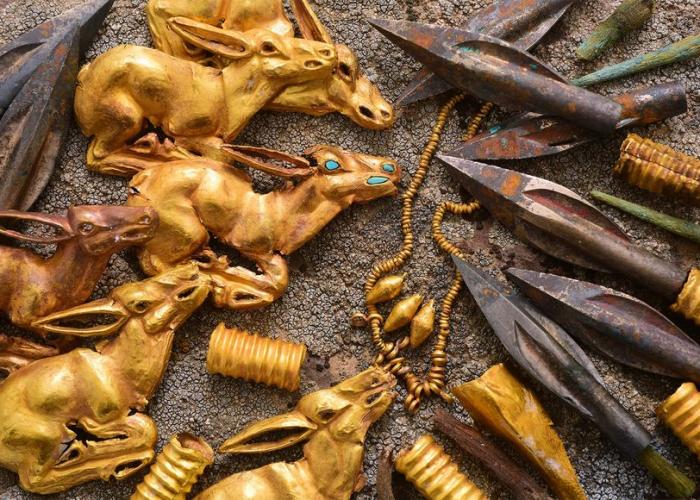"And now we will set off to the Zaysan District to visit the famous royal burial mounds of the Shilikti Valley" said Grandpa.
"What's in there?" the boy asked.
"There are about a hundred ancient burial mounds there. They hide the mysteries of epochs, rulers and cultures. Scientists will have to unravel these mysteries. Archaeologists conducting their excavations there believe that the valley was the headquarters of the powerful rulers of the Great Steppe."
"Have they managed to find anything?" Sanzhar was curious.
"Oh, amazing finds!" said Grandpa, "They discovered more than four thousand gold pieces of very high quality there. For example, tiny gold earrings and pendants made by nomadic steppe people three thousand years ago. You and I will go through the places where our ancestors lived, try to imagine the pictures of the past and get into the spirit of that time.
"Is there a legend about this place?" Sanzhar asked, having already got used to hearing all sorts of stories from his grandfather.
"No – None that I heard of" he sighed.
"Grandpa, let's make up our own story then!" Sanzhar suggested.
"A story?" grandfather asked in surprise. "You and me? But we are not storytellers... Okay, let's give it a try!" He suddenly agreed, looking at the pleading expression on his grandson's face. Some time later, on the basis of historical facts, they composed their own story about the Shilikti Valley, which Sanzhar's grandfather then told everyone for a long time, as a beautiful old legend.
Once upon a time, the endless steppe expanse of the Shilikti Valley was inhabited by ancient tribes. It was surrounded by mountains on three sides: in the south and west – Tarbagatai, in the east – Saur, in the north – Manyrak. The valley stood out from the others with its favorable climate: summers were cool here, and winters were warm and snowless. Blooming gardens were fragrant there from spring to autumn. The ancient trees provided a saving shade. The steppe lands were covered with green carpets of exotic herbs, and graceful animals of extraordinary beauty roamed on their expanses: gazelles, antelopes and deer. Great spirits guarded these lands. And wonderful people lived there – masters of their craft: miners and blacksmiths, potters, bone cutters and stone cutters, jewelers and joiners, glass blowers and tanners, tailors and weavers, wood carvers and sculptors. Their craft was their breadwinner. They were also held in high esteem. With the skills of mining, the ancient miners extracted gold, silver, emeralds, semi-precious stones and iron ore from the mines.
The vast Shilikti Valley attracted traders from all over the great steppe. Merchants of different nationalities and religions used to come here from afar. People traveled large distances in order to arrive at the rich fair in Shilikti and buy outlandish goods.
And in the neighboring lands at that time there lived an evil and envious leader of one of the local tribes, who was a very arrogant man and loved power more than anything else in the world. The leader had untold riches and was immensely proud of them, bragging in front of other leaders to impress them. One day he heard that the skilful metalworking masters of the Shilikti Valley had made magic armor and an unusual crown. Half of it was cast in gold, and the other half was cast in silver. The gold part was decorated with precious stones and amber, while the silver part sparkled with black diamonds. It was rumored that the one who would become the owner of a magic crown and put it on his head would be able to conquer almost the whole world, becoming its new ruler and gaining unlimited power. As soon as the ruler heard about the local curiosity, his heart was inflamed with a thirst to get the miraculous crown, single-handedly take possession of it and become renowned, making himself the great "master of the Universe". And he also wanted to get hold of the magic armor that would bring victory to its owner. He sent his horsemen to ravage the beautiful city of craftsmen and get him the desired trophies.
However, a miracle happened. Once the enemies came close to the gates of the city, it suddenly fell into the ground along with all its buildings. The native land could not withstand the enemy onslaught. It abruptly opened up and shrouded the city within itself. Thus, the bright city of craftsmen was plunged into darkness and disappeared.
There is a saying among the folks: "The secrets are opening all the gates to their masters".
Only ancient stones, mysterious rock paintings and numerous steppe mounds remain. They keep their secrets securely. Who knows – perhaps these are mysterious monuments of a glorious tribe of craftsmen that hid under their native land?

